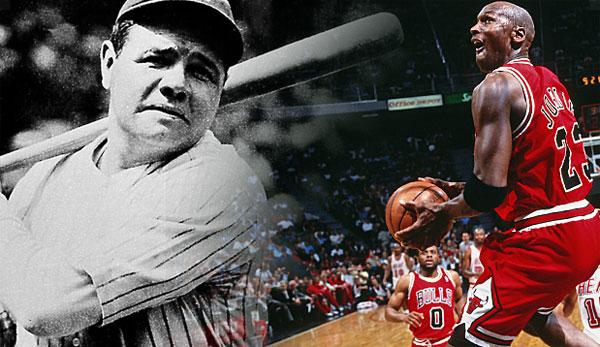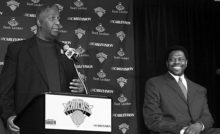When you think of baseball, you inevitably think of Babe Ruth. Perhaps the biggest name in the history of Major League baseball is considered an icon of American sport. An unparalleled star who broke through the boundaries of sport long before any other athlete. It was he who made later idols like Michael Jordan possible. Exactly 83 years ago, The Babe hit his last home run. SPOX takes this as an opportunity to look back on the unique history of the Bambino.
A stable, lateral stand, the right shoulder points forward, the right leg as well and is slightly turned in. The hands grip around the bat, bob back and forth slightly in front of the chest. And then … a bang, a bang!
Sometimes it only takes one movement. A shot, a jump, an inspiration and the career of an athlete changes forever. The athlete apparently creates an iconic image out of nothing, which remains forever in the heads, which sounds forever in the ears: Rahn, Ali, Jordan, Bolt – the list can be continued as desired. They would not all be here, they would not have been captured forever in this immortal myth of images and stories if a very, very strong boy had not been born in Baltimore, Maryland on February 6, 1895. His name: George Herman Ruth Junior – the first homerun king of baseball, the first Hollywood athlete. The first great icon of the sports world or as they say in the States: “He was larger than life.”
Ruth is the blueprint for every good sportsman’s biography: The parents German immigrants from the Palatinate and operators of a sad dive in the poorest corner of Baltimore. Bar and child-raising? Difficult. Little George spent most of his time smoking and drinking in the street when he was young, problems seemed to attract him magically. Numerous fights and theft offences made him known in the neighborhood.
George only went to school when he felt like it anyway. That’s why the parents pulled the emergency brake at some point. For seven-year-old Ruth, he went to a Catholic home for children who were difficult to raise, even though at first he always ran away to show up every evening for a few beers at his parents’ pub counter. In the course of time and in the regular operation of the school team, however, Babe fell in love with baseball. Pitching and punching. Two simple movements and already at the beginning of the 20th century the most popular sport in the USA. But until America’s favorite pastime there was still something missing, respectively someone.
Tall, a massive upper body, long arms – Ruth quickly became a local phenomenon thanks to his sporting talent. The physically impressive boy led the school team of St. Mary’s Industrial School For Boys from one victory to the next. Brother Matthias, one of the priests in the strictly Catholic institution, played a major role in this. He promoted the talent of the energy bolt, who was later called Babe because of his youthful character.
Everyone knew Babe. He was loud, rude, hearty and could devour more food than any residual ton of a supermarket. Matthias was the first adult in Babe’s life to realize the talent of the rebellious boy. But making money with baseball? Pitching and punching? A dream that seemed even more hopeless then than today.
American sport was one of the first to allow professional players, but the baseball landscape at the time was much more like a circus on the road. The short Major League season took place only in the larger cities. The teams made more money with show matches. No village too small, no place too remote. The players were on the road for almost 365 days and had short-term contracts alone. Only the really big names could lead a carefree life with their salary. That didn’t put Ruth off. As a left-handed pitcher, he took detours to the Boston Red Sox. It didn’t take long before Ruth made a name for herself there, too.
Despite his conspicuous talent, his cheeky manner quickly clashed with almost the entire team. So he was not only forbidden to practice batting for sporting reasons. He was supposed to pitch, that’s what he got paid for. No more, no less. When he was caught repeatedly taking the bat in his hand, all his clubs were sawed into two pieces.
Nevertheless, nobody could prevent his debut in the Major League Baseball in 1915. The first matches went off without great highlights until the first meeting with the New York Yankees took place. The perfect stage for the first exclamation mark. Ruth entered the Batter’s Box as a great stranger, opposite him Stand Jack Warshop, who is still known to the USA today mainly because he allowed the first home run of the great Bambino. Already the first shot sat, Ruth catapulted the ball with his left swing brutely through the mild spring air directly into the upper rank of the stands in the right field. The 8000 spectators rubbed their eyes in surprise.
According to the New York Evening Journal, Warshop then looked at the youngster “reproachfully, who was so bold as to do such a thing to a colleague.” Yeah, to do. A home run was an absolute rarity and a disgrace to any pitcher at that time. Baseball was enormously defensive, pitcher determined the dynamics of a game, while batteries should allow short runs from base to base, especially with safety shots. It was that uncompromising risk appetite that set Ruth apart from all players at the time. He developed a simple mantra during his career: “Every strike brings me closer to the next home run.”
Nevertheless, he celebrated his first World Series titles (1915, 1916) with the Boston Red Sox mainly as a successful pitcher. Especially his performance stands out in game 2 of the 1916 series. His complete game against the Brooklyn Suberbas (predecessor of the Dodgers) is the longest in the history of MLB playoffs with 14 innings to date. The curious thing: Especially his strong pitching performance prevented Babe from appearing more often than Batter for a long time. As the MLB’s alleged best left-handed pitcher, the management found it difficult to give the young, reckless star even more tasks; much to Ruth’s displeasure. Besides his “job” as a pitcher, he loved to hit the ball from time to time in the direction of the sky.
His happiness: The fans loved to watch him do it. The tough move of his thunderclaps, which were fully designed for risk, slowly made its rounds on the east coast. That’s why the franchise at some point had an understanding – more viewers, more revenue. In May 1917 Ruth made four home runs in four games for the first time and finally moved up to the batting order. His popularity literally exploded. Everyone wanted to see the next ball fly through the stadium like a comet. Even his strikes were celebrated by the audience: “When Ruth puts a swing next to the ball, the crowd starts yelling immediately,” a journalist from Boston noted.
And Ruth was getting better and better. In 1918 he easily broke the AL season record set by Ralph Seybold, who had beaten 16 home runs in 1902. In the middle of the summer the MLB record was gone (24). Ruth finally finished the season with 29 home runs and became the first player to make a home run in all 8 MLB stadiums. However, the final hype only broke out when the then Red Sox owner, theater marketer Harry Frazee, was forced to sell the crowd puller to New York for financial reasons. To this day, many Bostonians believe in a conspiracy. After all, Frazee himself was from New York and is said to have arranged a deal underhand with Yankee owner Jacob Ruppert.
For 100,000 dollars (at that time the highest transfer fee in the world of sport) the contract of Ruth changed in 1919 to what is still the largest rival of the Red Sox. This change is still considered one of the greatest’steals’ in sports history. While the Yankees became one of the most successful and prosperous teams in the sporting world, Boston suffered the “Curse of Bambinos” from 1918 to 2004: for 86 years, the Red Sox were not to win another World Series title. But the change marks a historic turning point not only from a baseball point of view. The right person, the right place, the right time. Ruth, New York, the Roaring 20s.
Page 1: Babe Ruth: The first superstar of the sports world
Page 2: Babe Ruth: The media and economic phenomenon




